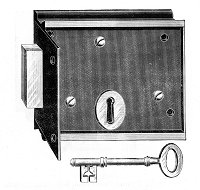
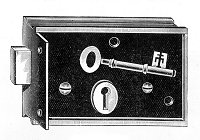
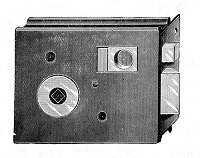
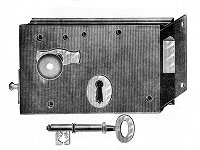

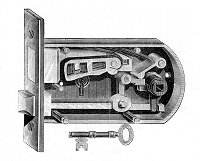
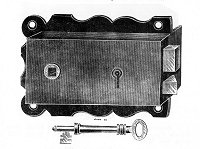
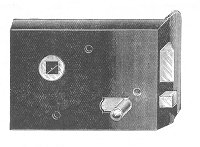
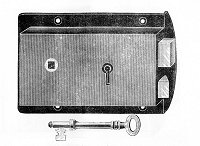
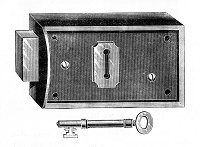

|
Wolverhampton started life as an agricultural settlement, boosted by
becoming an ecclesiastical centre, and then becoming a market town
providing not only a market but, almost certainly, a range of other
services as well. It may be that it was this agricultural connection
that first led to the metal bashing and engineering industries appearing
here, for not only would Wulfrunians find a living in selling clothes,
shoes and other necessities to those who came in to market but they
would also be able to sell agricultural implements. Certainly they did
not start this kind of work because coal and iron and limestone were
found within the borough boundaries. They were not. But they were close
enough at hand for enterprising people to be able to exploit them.
Although locks of some sort had been used throughout history, changing
social conditions and aspirations, increasing wealth and capital
accumulation, a change from community to individual capitalism, would
have combined with improved metal winning and working, to make locks a
promising market. It is quite likely that lock making here would have
started as a local trade, possibly even in conjunction with farming, for
it was not at all uncommon for farmers to augment their income with a
specialist trade and even town dwellers were often both farmers and
artisans.
So at some imprecise time lock making appeared in Wolverhampton,
Willenhall and their environs. The raw materials were near at hand. The
skills were acquired goodness knows how but were soon handed down from
parent to child and from master to apprentice. The market would
originally have been local but it seems that, despite the town's having
bad communications, the market expanded. Locks were small enough
to be transportable by pack horse and waggon. As roads
improved and canals were built, the potential market became wider. But
there is nothing to say why Wolverhampton became a lock making centre
when it had the same starting point as many other places. It must be
related to some kind of local entrepreneurial spirit – and who can say
what would explain that?
In the earliest lock making times the makers would have been one family
outfits. In the course of time, as the market expanded, firms could grow
larger and some became very large. But even to the end of the lock
making days, there were still one family outfits hard at work.
According to J C Tildesley, Locks and Lockmaking, the "introduction of
the lock trade into South Staffordshire took place as early as the reign
of Queen Elizabeth, but it did not flourish very extensively until the
end of the 17th century." His authority for this
account of earlier times is not cited. But the time of "the reign
of Queen Elizabeth" may not be earlier enough. St. Peter's church
contained, in medieval times, a chapel to St. Loe who was the patron
saint of lock makers and metal workers. The chapel is not dated in
the records but it maybe that this shows that lock making in
Wolverhampton went back to before 1485. (For a fuller account of this
evidence, see the
article on St. Loe on this web site).
Tildesley gets onto firmer ground with the Hearth Tax of 1660 when,
it appears, most of the 84 hearths in Wolverhampton and 95 in Willenhall
"were used by the locksmiths of those times". That might be worth
checking a bit more closely. But Dr. Plot, writing in 1686 also
comments that the "greatest excellence of the blacksmith’s profession in
this county lies in their making of locks for doors, wherein the
artisans of Wolverhampton seem to be preferred to all others …".
This suggests that by the end of the 17th lock making was
well established and was certainly more than a local trade; and that
Willenhall and Wolverhampton both had lock making industries. At that
time to the structure of the trade was, according to Tildesley,
beginning to change. Originally the locks made by the individual
manufacturers "were purchased by chapmen who travelled from place to
place with packhorses. At the commencement of the eighteenth century,
however, the merchants began to establish store rooms in Wolverhampton
and Birmingham, wither the locks and other hardware productions were
conveyed by the smiths, in wallets". (He wrote in 1866 and was
able to add that this system, was "not even yet quite obsolete" and that
the "oldest ware-room in Wolverhampton is that of Messrs. Tarratt, Sons
and Co,. in the Townwell Fold, which has been established considerably
more than a century").
According to Mander (p.143), the Sketchley and Adams trade directory of
1770 shows that the "predominating industry was still that of
lockmaking; no less than 118 names are listed under this head.
Bucklemaking follows, a very close second, with 116". He also deduces
that "lockmaking … had become very specialised. 24 different types of
lock are mentioned – from the ordinary gate lock to the secret bag lock
and the tea chest lock. Often a single person represents an entire
branch of the trade; John Ryley, for example, is the only man to be
described as a letter and baglock maker. George Fox, of Berry Street,
appears as a bitted and swallow bow lock maker, and Thurston Groom, of
Stafford Street, as the only outside box lock maker. The great majority,
however, appear to have been engaged in the manufacture of cabinet
locks; there are three times as many names under this head as under any
other, and, in addition, we find eight cabinet key makers listed".
Of course the brief entries in the directory may cover the fact that
the makers named could and did make other types of lock, the named one
being their preference or speciality. In any case our local lock makers
were renowned for their ingenuity as well as their skills and several
patents were taken out by local men even before the large manufacturers
moved in.
George Price (1856) noted that in 1770 that the numbers of lock making
concerns was:
Wolverhampton 134
Bilston 8
Willenhall 148
By 1855 he records that Willenhall’s slight ascendancy had become a
predominance:
Wolverhampton 110
Bilston 002
Willenhall 340
These raw numbers are not as revealing as they might be – the value of
the trade in each area might have been more informative – but they do
seem to indicate that, during the period covered, Willenhall established
the ascendancy it ever after maintained.
|